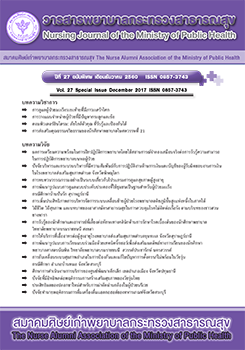Development of Community-based Palliative Care Model for Patients with Cancer: A Case Study of Banpunruk Suratthani
Main Article Content
Abstract
The purpose of this community-based participatory action research (CPAR) was to develop and examine the model of palliative care for patients with cancer at Banpunruk, Suratthani. The participants included health care providers, organizations and members of the community, and patients and their families. The PAR process included problem identification and a need assessment, community and team establishment, field and community context surveys, organization founding, model of care planning, action and inquiry(PDCA), outcome evaluation, and model development and distribution.
The result of the study was the development of the Banpunruk Model, which is a community-based palliative care model for patients with cancer. The model development enables concepts of care as well as a model and its outcome in care management appropriate for Banpunruk’s contexts. The concepts of care are based on social support, holistic and humanized care as well as community participation and ownership. The model of care and its model outcomes at Banpunrug integrates the distinctive concepts of Home, Hotel, Hospital, and School Model (HHHS model) to promote a caring atmosphere for patients and families, the community, and healthcare teams in the provision of care to the patients, who live in Banpunruk which mimics staying in their own house, hotel, hospital, and in school. Therefore, patients and families can learn how to take care of themselves and to effectively live well with cancer. Most importantly, they are prepared for a peaceful death. However, the Banpunruk Model is not a perfect one; there are some problems and barriers in its implementation relating to funding and commitment of volunteers.
Article Details
บทความและรายงานวิจัยในวารสารพยาบาลกระทรวงสาธารณสุข เป็นความคิดเห็นของ ผู้เขียน มิใช่ของคณะผู้จัดทำ และมิใช่ความรับผิดชอบของสมาคมศิษย์เก่าพยาบาลกระทรวงสาธารณสุข ซึ่งสามารถนำไปอ้างอิงได้
References
2. National Health. National strategic plan for health promotion at the end of life 2556-2559 B.E. based on the 2nd consensus of health assembly Tuesday 17, December 2014 at Impact Conventional Center, Maungthong Thani, Nontaburi. Samdi Printing Equipment Ltd. 2016. (in Thai)
3. A goal to expand palliative care service in 300 community hospital linking 30,000 teams of family doctors in September [Internet].2014 (cited 2015 Jan 27).Available from http://www.hfocus.org/content/2015/03/9603. (in Thai)
4. Sukcharoen P, Wisesrith W. Nursing service system for palliative care in tertiary hospitals. Kuakarun Journal of Nursing.2014: 21 (Supplement December): 155-67 (in Thai).
5. Pattniboon W ,Pratunon J, Kaewmafai J. Model development of palliative care for elderly with end Stage chronic illnesses at medical unit II, Loi Et Hospital.Journal of Nurses’ Association of Thailand, North-Eastern Division.2012;30(3):68-77(in Thai).
6. Preston R, Waugh H, Larkins S, Taylor J. Community participation in rural primary healthcare: intervention or approach?. Australian Journal of Primary Health. 2010;16: 4-16.
7. Barnett TM. Participatory Action Research. Social Work, 2016; (61): 95-95. DOI:10.1093 /sw/swv049.
8. MacLeod A, Skinner M, Low E. Supporting hospice volunteers and caregivers through community-based participatory research. Health & Social Care In The Community [serial on the Internet]. (2012, Mar), [cited September 26, 2017]; 20(2): 190-198. Available from:CINAHL Complete.
9. Gehlert S, Coleman R. Using Community-Based Participatory Research to Ameliorate Cancer Disparities. Health & Social Work [serial on the Internet]. (2010, Nov), [cited September 26,2017]; 35(4): 302-9. Available from:CINAHL Complete.
10. Cacari-Stone L, Wallerstein N, Garcia A, Minkler M. The Promise of Community-Based Participatory Research for Health Equity: A Conceptual Model for Bridging Evidence With Policy. American Journal Of Public Health [serial on the Internet]. (2014, Sep), [cited September 29, 2017]; 104(9): 1615-23. Available from: CINAHL Complete.
11. Bureau of Policy and Strategy, Bureau of Non Communicable Diseases, Ministry of Public Health. S Sawasdimongkol (editor). Annual Report 2015.Nonthaburi.Thai Veteran Printing; 2016.104 p. (in Thai).
12. NCD data: Numbers and death rates and injuries in calendar year 2015.[Internet]. 2014 (Cited 2015Dec12).Available from http://www.thaincd.com/2016/mission/documents.php?tid=32&gid=1-020
13. Donabedian A. Evaluating the quality of medical care...reprinted from The Milbank Memorial Fund Quarterly, Vol. 44, No. 3, Pt.2, 1966 (pp. 166-203). Milbank Quarterly[serial on the Internet]. (2005, Dec),[cited January 2, 2017]; 83(4): 691-729. Available from: CINAHL Complete
Sakulpong P. Love Sharing House.A project supporting plan for promotion at the edn of life 2557-2559 B.E. Thai Health Promotion Foundation. 2016; 114 p. (in Thai)
15. Albrecht T, Bruera E, Del Fabbro E. An interdisciplinary outpatient palliative care model for cancer patients: successful and reproducible (TH307). Journal Of Pain & Symptom Management [serial on the Internet]. (2016, Feb), [cited January 2, 2017]; 51(2): 318-9. Available from: CINAHL Complete.
16. Bartley C, Webb J, Bayly J. Multidisciplinary approaches to moving and handling for formal and informal carers in community palliative care. International Journal Of Palliative Nursing [serial on the Internet]. (2015, Jan), [cited January 2, 2017]; 21(1): 17-23. Available from: CINAHL Complete.
17. Hsien S, Brazil K, Sussman J, Pereira J, Marshall D, Barbera L, et al. Impact of community based, specialist palliative care teams on hospitalisations and emergency department visits late in life and hospital deaths: a pooled analysis. BMJ: British Medical Journal [serial on the I n t e r n e t ] .(2014, June 14), [cited January 2, 2017]; 348(7962): 14. Available from: CINAHL Complete.
18. Rosenwax L, Spilsbury K, Arendts G, McNamara B, Semmens J. Community-based palliative care is associated with reduced emergency department use by people with dementia in their last year of life: A retrospective cohort study. Palliative Medicine [serial on the Internet]. (2015, Sep), [cited January 2, 2017]; 29(8): 727-36. Available from: CINAHL Complete. 3
Riffin C, Kenien C, Ghesquiere A, et al. Community-based participatory research: understanding a promising approach to addressing knowledge gaps in palliative care. Annals of palliative medicine. 2016;5(3):218-24. doi:10.21037/apm.2016.05.03.
DiMaglio L, Williams A. Shared care: the barriers encountered by community-based palliative care teams in Ontario, Canada. Health & Social Care In The Community [serial on the Internet]. (2012, July), [cited January 2, 2017]; 20(4): 420-9. Available from:CINAHL Complete
14. Kendrick L. How to conduct participatory action research: an exemplar. In: De Chesnay M. Nursing research using participatory action research : qualitative designs and methods in nursing [monograph on the Internet]. New York:Springer Publishing Company; 2014. [cited September 29, 2017]. Available from: eBook Collection (EBSCOhost).

